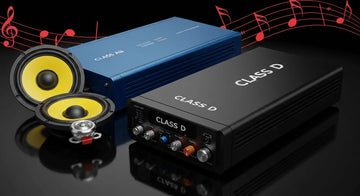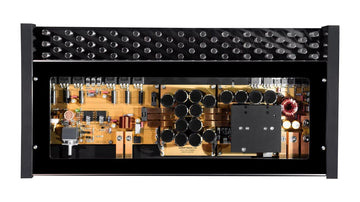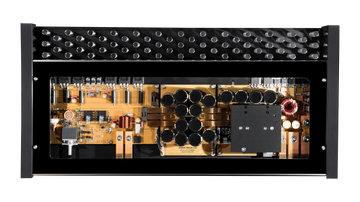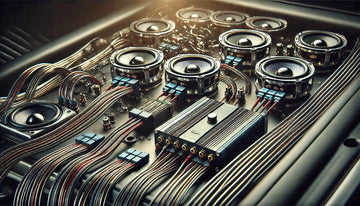When you want a strong and clear car audio system, picking the right amplifier is key. The kind of amplifier you choose can affect how your music sounds. A Class AB amp and a Class D amp are the two top picks. Each has its own set of features, good points, and things it does best. In this guide, I will help you see how each one works when used in real life. I will talk about sound quality, power output, how much heat they make, their size, and how well they use energy.
How Class AB and Class D Amplifiers Work
Class AB amplifiers use ideas from both class A and class B amps. In this design, there are two transistors that each work during different halves of the sound wave. Because of this, class AB amplifier circuit amps help cut down crossover distortion that can happen with class A or class B setups. People like ab amplifiers for clear and true sound, especially audio fans. But class AB amplifiers do generate more heat and are not as power-efficient as some other types.
Class D Amplifiers use fast switching to boost the signal and keep the right supply voltage. This type is very good at saving power. Most d amplifiers are about 85–95% efficient. You will notice that they are smaller and do not get as warm when running.
Because of new ideas in technology, modern class d amps give you amazing sound quality. They can now match or even beat many AB amps. Many people say class d models work well, feel light, and make things run smooth.
Sound Quality Comparison
Class AB amps are well-liked because they give a warm and real sound. They make low distortion at middle and high tones. These amps offer good output power. Many people pick them for good sound quality builds. A lot of folks use them to power full-range speakers or tweeters.
Class D used to be seen as harsh or too digital, but it has really come a long way. Now, the best Class D amps give very clear sound. They also handle bass very well. This type is great for SPL builds, because subwoofer performance is so important in these. You get strong sound, high power, and good sound quality with Class D now.
"I have used both types in my truck. The AB sounded more clear and nice with my speakers. I changed to class d for the subs because I needed more room and less heat. That choice also meant I had to pay close attention to the amplifier design."
Class AB vs Class D Amplifiers: Power Efficiency & Heat Management
Class D amps are really good when it comes to saving power. With power efficiency as high as 95%, these amps do not lose much energy to heat. So, they are great for tight installs and times when you need more wattage.
Class AB amps usually work at 50–65% efficiency. This makes them give off more heat. They need big heatsinks, and there can be problems like thermal shutdown if the space does not have good airflow.
Metric | Class AB | Class D
Efficiency | 50–65% | 85–95%
Heat Generation | High | Low
Thermal Risk | Medium–High | Low
Size, Cost, and Installation Considerations
Class D amplifiers, thanks to their higher efficiency, are generally smaller and lighter than their Class AB counterparts. This compact size and reduced weight make them particularly suitable for automotive applications, where space is limited and the available power supply may not be as robust. Their efficient design means they waste less energy as heat, allowing for simpler cooling mechanisms, which further contributes to their compactness.
On the other hand, Class AB amplifiers tend to be larger and heavier due to the need for more substantial internal components and more elaborate heat dissipation systems. These features help manage the greater amount of heat generated during operation. The robust build of Class AB amps often translates into a higher price point, especially for premium models that use high-quality parts aimed at maximizing audio fidelity.
From a cost perspective, Class D amplifiers are typically more budget-friendly on a per-watt basis. They offer good performance at a lower price, making them an attractive option for those seeking efficient amplification without breaking the bank. However, many audiophiles argue that Class AB amplifiers deliver superior sound quality—often described as warmer or more natural—especially at lower volumes or in high-fidelity audio systems. As a result, enthusiasts who prioritize listening experience may be willing to invest more in a top-tier Class AB amplifier despite its higher cost and bulkier form factor.
In summary, the choice between Class D and Class AB amplifiers often comes down to balancing factors such as physical size, cost-efficiency, power output, heat management, and personal preference regarding sound quality. For car installations or situations where space and efficiency matter most, Class D is usually favored. Meanwhile, for home audio setups where ultimate sound quality is desired—and space or budget is less of a concern—Class AB remains a popular choice among discerning listeners.
Best Use Cases – Which Amp is Right for You?
Use Case | Recommended Class
Sound Quality Builds (SQ) | Class AB
Subwoofer Power (SPL) | Class D
Tight Vehicle Installations | Class D
Classic/Vintage Audio Lovers | Class AB
Budget-Friendly Systems | Class D
If you want to power full-range parts and really care about a deep, clear sound, pick class ab. If you want more bass, or you want your speakers to be loud and save space and power, class d will be the better choice for you.
Understanding Biasing in Class AB Amplifiers
Biasing in Class AB amplifiers is very important. It has a direct effect on how well and how efficient they work. Biasing is the way you set the working point for the output transistors. This is done to make sure that they work properly all the time when an input signal is present. In Class AB designs, you want both output transistors to be a little bit 'on' even if there is no input signal. This helps to lower crossover distortion, which can be bad for audio quality. One transistor takes care of the positive half of the input waveform. The other handles the negative half. There are several ways to do this, like fixed voltage biasing, resistor biasing, and diode biasing. Each method comes with its own good and bad points.
A good bias point helps the two transistors work together well in ab amplifiers. This means the amplifier can switch between them more easily when the sound gets louder or changes fast. With the right biasing, the amplifier can handle class ab signals better. If the bias is not set right, there can be more distortion. This is a problem when sounds change quickly. That is why it is important to know how biasing works when you want to get the best out of class ab amplifiers.
Voltage and Resistor Biasing Techniques
When you use biasing in Class AB amplifiers, you can pick from two main ways. You can use voltage biasing or resistor biasing. If you use voltage biasing, it means you set up a fixed voltage from a supply. This helps the transistors stay on and be above their cutoff points. With that setup, a small amount of current keeps flowing even when there is no sound. This small current helps stop crossover distortion, so you get less distortion in the sound overall. Still, using this method is not easy in practice, because making a special voltage source can be hard and can cost a lot.
Resistor biasing is used a lot in amplifier circuits. In this setup, several resistors make a voltage divider. This gives the needed bias to the transistors. The method gives a good way to save money. It is also easy to use in small amplifier units.
The resistors help drop voltage. The quiescent current makes sure the transistors stay ready even when there is no audio input. Power dissipation happens in this process. This must be thought about when planning the circuit.
It is important to pick the right resistor values. This affects how stable the amplifier is with heat and how well it works when the load changes.
Also, the conduction angle is a key part of these biasing ways. In class ab amps, the conduction angle often goes from 180 degrees up to 360 degrees. This means both output transistors work together at the same time for some of the input wave. That helps make the sound more even and cuts down on distortion. By changing the supply voltage and resistor values, you can adjust the conduction angle. This lets people get the sound quality and efficiency they want from class ab amplifiers.
Real-World Test: Performance in Action
We tested a Class AB and a Class D amplifier. These were both used with the same subwoofer and component speaker setups. The test was done in a 2023 Ford Maverick.
-
Sound Clarity: The AB amp gave mids and highs that be smooth and clear.
-
Bass Control: You get better and deeper bass with class d.
-
Temperature After 30 Min: The AB amp got up to 140°F. The class d amp stayed cool at 102°F.
-
Voltage Draw: The AB amp took about 15% more power than class d when both played at the same volume.
What the Pros Use in Competition
In sound quality (SQ) competitions, many professionals continue to favor Class AB amplifiers for component speakers due to their superior fidelity and cleaner sound reproduction in the mid and high frequencies. Class AB amplifiers are renowned for delivering a warm, detailed audio response with minimal distortion, which is essential when judges evaluate the subtle nuances of music clarity and tonal accuracy. These characteristics make them an ideal choice for tweeters and midrange drivers where precision matters most.
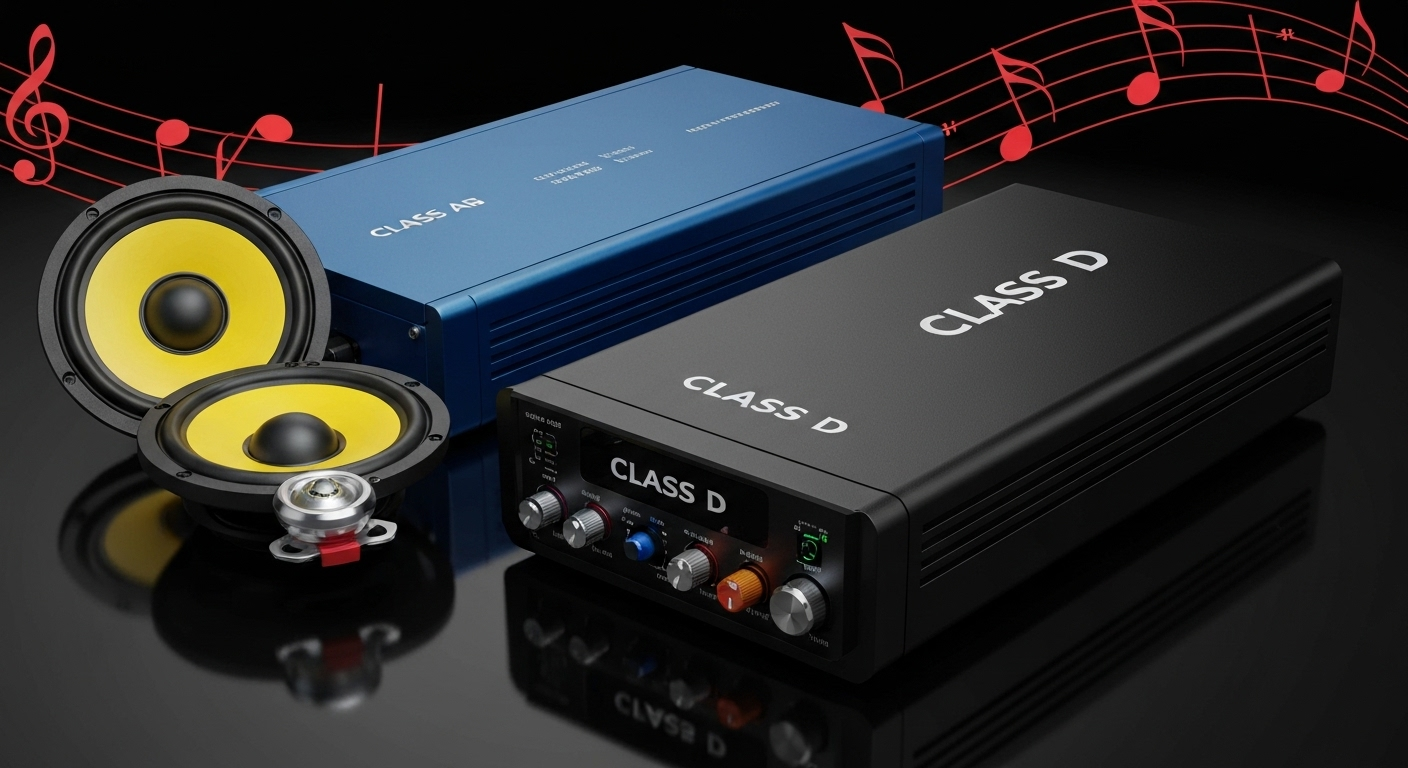
On the other hand, in sound pressure level (SPL) events—where the primary goal is achieving maximum loudness—Class D amplifiers are overwhelmingly preferred. The chief advantages of Class D technology are its exceptional efficiency and ability to produce vast amounts of power without significant heat loss. This makes it suitable for driving subwoofers that require immense wattage to produce earth-shaking bass, all while minimizing strain on a vehicle’s electrical system. As Scott Welch, founder of Audio Intensity, points out: “I still use class AB for my high sounds, but class D is the only way to give a lot of power to my subs without hurting my car’s wiring.” His perspective reflects a common approach in the car audio community—using each amplifier type where it excels most.
The choice between Class AB and Class D ultimately comes down to application and priorities: audiophiles seeking pristine musical detail will gravitate towards Class AB for their front-stage speakers, while competitors aiming for record-breaking decibel levels turn to Class D for their subwoofer setups. Some advanced systems employ a hybrid approach—utilizing both amplifier types—to balance sound quality with sheer output power, ensuring impressive performance across the entire frequency spectrum.
Final Thoughts & Recommendations
Both amplifier types and the different types of amplifier classes are important in today's car audio world. Class AB is still seen as the best when it comes to tone and sound quality. On the other hand, class D stands out because it gives more power, works well, and it is more useful for many people.
Choose Class AB if:
-
You like the feel of analog sound and want it to have low distortion.
-
You are working on a setup for sound quality competition.
Choose Class D if:
-
You need a small setup that stays cool while it works.
-
You are using it for subwoofers or sound systems that use a lot of power.
Construction and Design of Class AB Amplifiers
The way Class AB amplifiers are built and designed is very important for how they work. These amplifiers mix ideas from both Class A and Class B models. In most Class AB amplifier designs, you find two output transistors. There is one NPN and one PNP. They work together in a push-pull setup. This helps with amplifying both parts of the input signal. It also helps keep crossover distortion low. In the output stage, everything is made to stay linear, so you get clear and good audio over different sound frequencies.
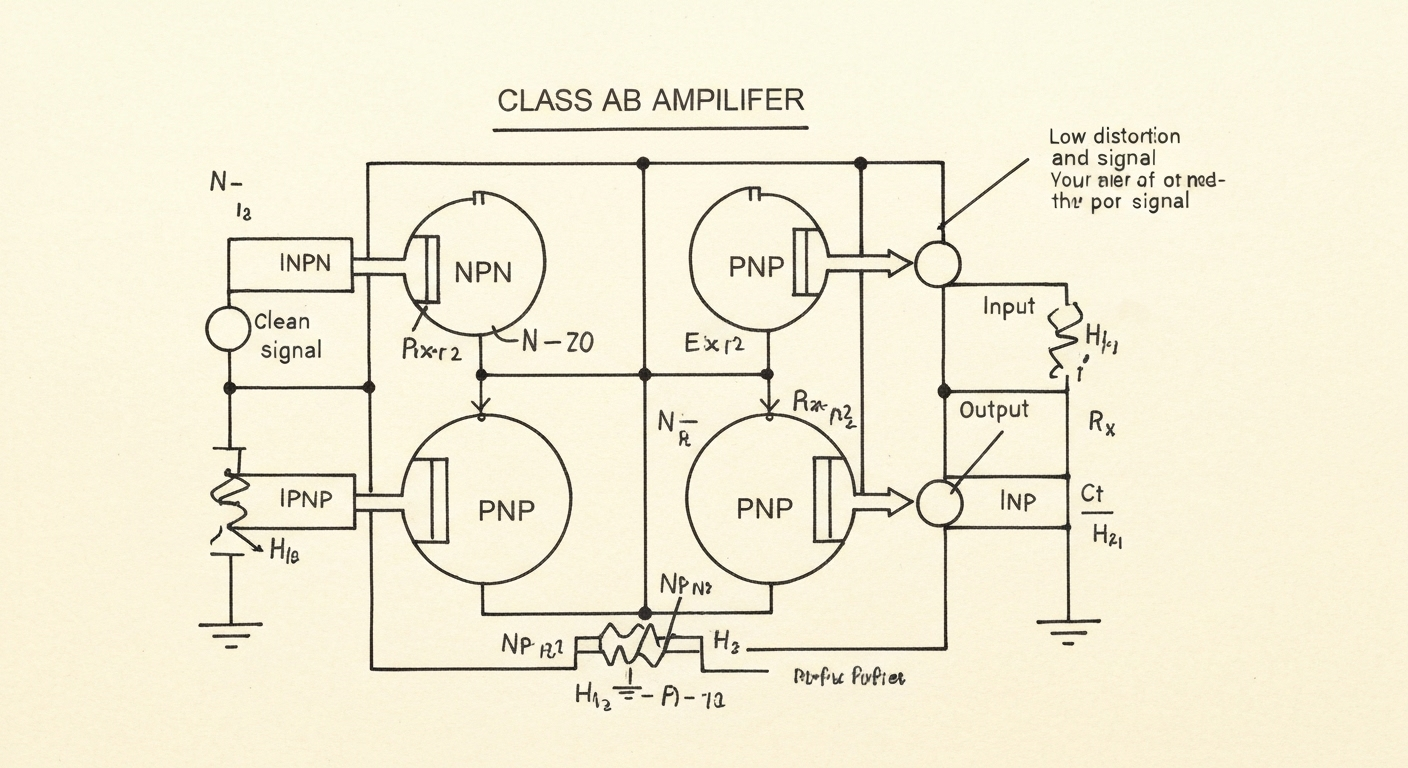
The design includes diodes in the biasing network. This helps to keep the biasing voltage steady, even when the temperature changes. This is important. It is because output transistors might change their output voltage if the temperature goes up or down. That can make things work less well or not as you want. When you put the diodes near the output transistors, it helps with heat changes. So, that keeps the quiescent current stable, no matter how you use it or how hot it gets. This way, the output transistors can work in a good way with a steady output voltage.
The design of Class AB amplifiers tries to balance good sound quality and better power use. These types of amplifiers work more efficiently when compared to class A models. They still offer a warm and natural feel in the sound, which a lot of people enjoy. Because of this, both class AB amplifiers and class C amplifiers are often picked for places where high sound quality and being able to trust the sound equipment matter most. This mix of strong design and the features people want makes them great for high-quality audio needs.
Explore Amplifier Options
Browse our expert-curated collections:
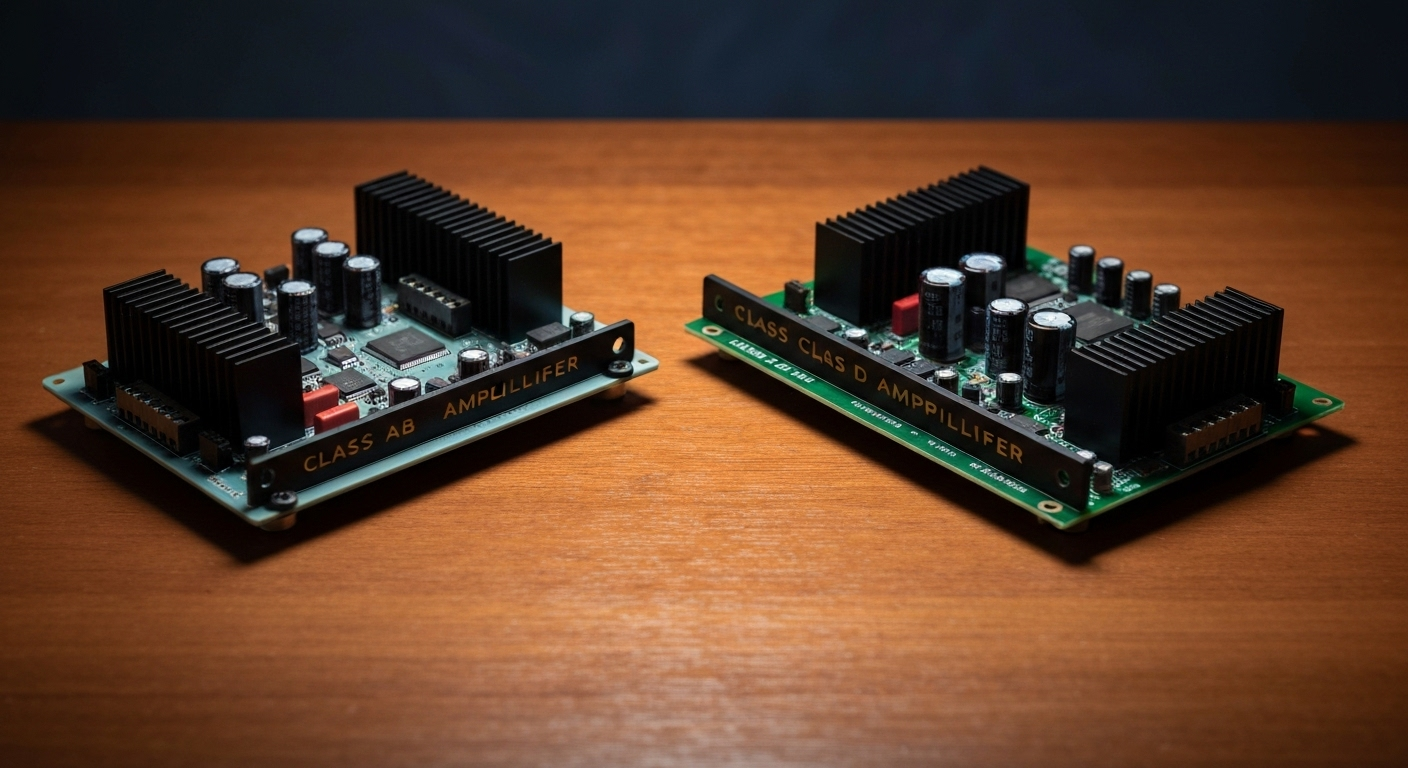
-
Class AB Amplifiers - Look at the output stage designs of class AB amplifiers. They can give you better performance.
Need help to pick the right amp? Get in touch with us. Our team will give you ideas that fit what you are looking for.

